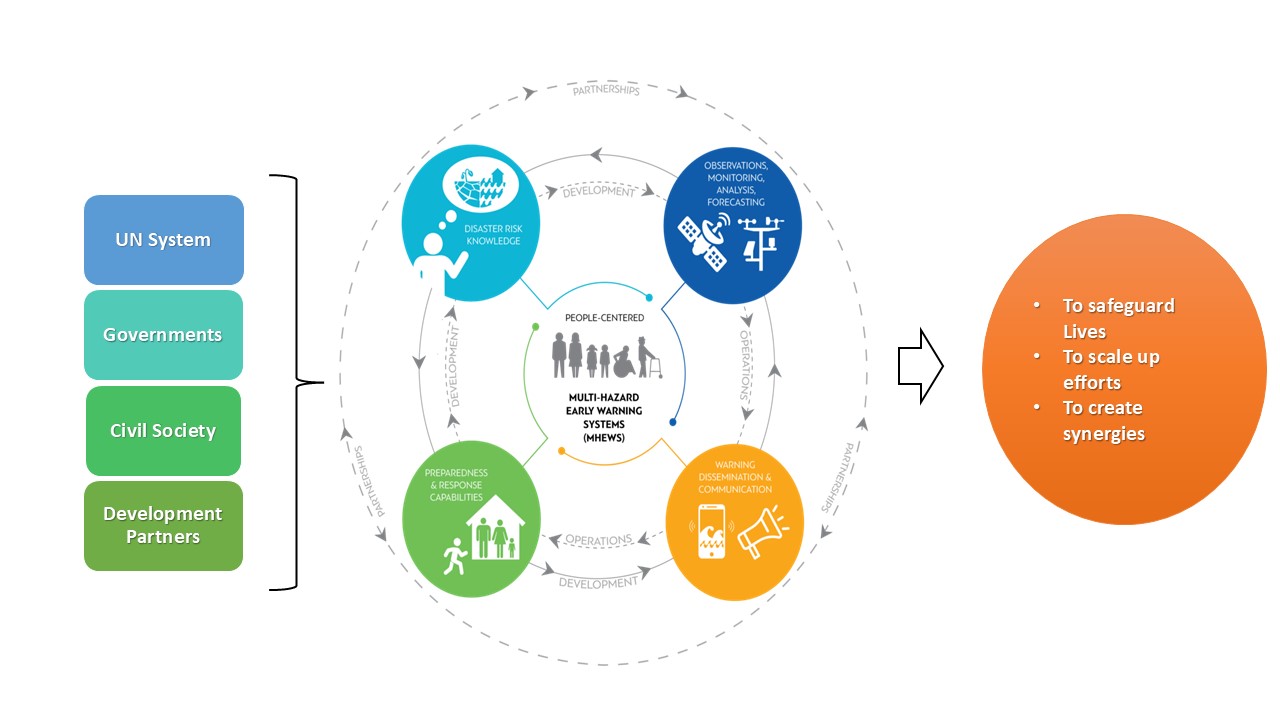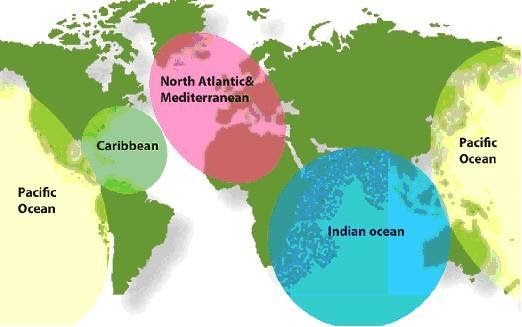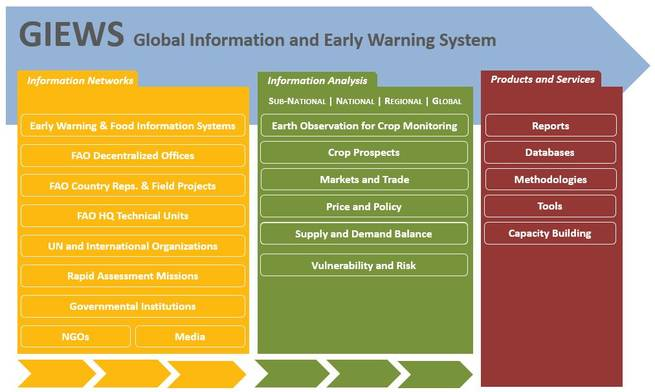Recognizing the usefulness of early warning systems, the United Nations has been operating early warning systems and advocating for their implementation and/or improvement for several decades. It has done so through dedicated efforts by specialized agencies, such as the Food and Agriculture Organization (FAO) of the United Nations and the Intergovernmental Oceanographic Commission under UNESCO (UNESCO-IOC), and through international conferences on disaster risk reduction and early warning, which led to the adoption of international frameworks and initiatives.
Early warnings for All
In the year 2022, the United Nations Secretary-General, António Guterres, launched the Early Warnings for All initiative to ensure that every person on Earth is protected by early warning systems within five years. This initiative seeks to provide universal protection against hazardous hydrometeorological, climatological, and related environmental hazards.
The Early Warnings for All initiative unites the broader UN system, governments, civil society, and development partners from both the public and private sectors under the umbrella of the World Meteorological Organization to strengthen collaboration and accelerate efforts to close gaps in delivering comprehensive, people-centered, multi-hazard early warning systems. The initiative seeks to scale up efforts and create synergies among initiatives and partnerships across various sectors. Its goal is to safeguard lives and livelihoods from natural hazards, including floods, heat waves, storms, and tsunamis.

Early warning efforts by specialized agencies
UNESCO-IOC
Since the early 1960s, the Intergovernmental Oceanographic Commission of UNESCO (UNESCO-IOC) has been working with governments around the world and other regional and international organizations to coordinate the implementation of tsunami early warning systems in oceans and selected seas. Efforts are conducted by the IOC Tsunami Programme to continually improve tsunami early warning systems around the world. To date, tsunami early warning systems have been established in the following geographic areas:
- Pacific Ocean
- Indian Ocean
- North Atlantic Ocean and Mediterranean Sea
- Caribbean Sea
Tsunami warning systems rely on Tsunami Service Providers such as the Pacific Tsunami Warning Centre in Hawaii, which monitor on a 24/7 basis data on earthquakes and data generated by buoys deployed at sea such as the Deep-ocean Assessment and Reporting of Tsunamis (DART) to assess whether an earthquake has triggered a tsunami. These tsunami service providers transmit bulletins and other products to national meteorological offices or National Tsunami Warning Centres (NTWCs) in countries exposed to tsunamis using a variety of communication means (satellite, internet, sms or fax) so that at the national level, NTWCs and national disaster management agencies can issue warnings in case of tsunamis.

FAO
In response to the food crises of the 1970s, the Committee on World Food Security of the Food and Agriculture Organization of the United Nations (FAO) decided to establish the Global Information and Early Warning System on Food and Agriculture (GIEWS). GIEWS compiles and reviews data on a variety of topics including global food production, consumption and trade, as this is essential to assess potential food insecurity conditions in countries around the world.
GIEWS combines a variety of data from sources at different levels (from global e.g. Earth observation to local) to generate reports that are useful for policy-relevant decisions made by governments at national and local levels. In addition, the information generated by GIEWS is used by FAO in regional reports, bulletins, as well as in GIEWS updates and special alerts.
As part of its activities, FAO also operates early warning efforts in case of insects such as locust plagues or swarms.

WHO
The World Health Organization (WHO) maintains a watch on all potential diseases that may spread to the rest of the world, including those transmitted by viruses. In 2005, WHO launched the third edition of the International Health Regulations that establish how WHO and countries will deal with transmittable diseases worldwide. The purpose and scope of these regulations are “to prevent, protect against, control and provide a public health response to the international spread of disease in ways that are commensurate with and restricted to public health risks, and which avoid unnecessary interference with international traffic and trade”.
As part of these regulations, national health authorities must notify WHO within 24 hours of assessment of public health information, of all events which may constitute a public health emergency of international concern within its territory in accordance with the decision instrument, as well as any health measure implemented in response to those events. The Director-General of WHO shall determine, on the basis of the information received, whether an event constitutes a public health emergency of international concern. In such a case, WHO will collaborate by providing technical guidance and assistance and by assessing the effectiveness of the control measures in place, including the mobilization of international teams of experts for on-site assistance, when necessary.
In the case of potential pandemic, WHO operates a 6-level phase procedure to keep track of cases and to warn other countries about potential transmissions. The procedure includes guidance on several topics including planning and coordination, situation monitoring and assessment, communications, reducing the spread of disease and continuity of health care provision.
As part of its early warning efforts, WHO operates its Strategic Health Operations Centre (SHOC) on a 24/7 basis to monitor global public health events and to facilitate international collaboration during public health emergencies and daily operations. On the basis of the information generated by the SHOC and WHO, ministries of health in countries take the appropriate actions to prevent or minimize the spread of diseases.
Together with FAO and with the World Organization for Animal Health (OIE), WHO has launched the Global Early Warning System for health threats and emerging risks at the human–animal–ecosystems interface (GLEWS). Its aim is to inform prevention and control measures, through the rapid detection and risk assessment of health threats and events of potential concern at the human-animal-ecosystems interface.
Brief history of UN efforts to promote early warning systems
An initial effort by the United Nations regarding early warning was conducted under the umbrella of the Intergovernmental Oceanographic Commission of UNESCO (UNESCO-IOC), as a way to coordinate efforts made by different countries in the Pacific basin to implement the Pacific Tsunami Early Warning System after the catastrophic Valdivia earthquake (Chile) in 1960. Subsequent efforts have been conducted by UNESCO-IOC to launch tsunami early warning systems in the Indian Ocean, the North Atlantic and the Mediterranean Sea and the Caribbean Sea.
To continue promoting the early warning agenda at the international level in the late 1980s, the United Nations launched in 1990 the International Decade for Natural Disaster Reduction. This decade-long effort included the first systematization of early warning systems at the global level covering a variety of natural hazards, which was conducted by several expert working groups established for that task. That systematization led to the publication Guiding Principles for Effective Early Warning.
The Second International Early Warning Conference was held in Bonn, Germany in October 2003. This conference established the elements for efficient, people-centred early warning systems. This conference was organized by the then United Nations International Strategy for Disaster Reduction and the Federal Government of Germany. Building on the outcomes of this conference, UNISDR established the Platform for the Promotion of Early Warning (PPEW) which operated between 2004 and 2009.
During the Third World Conference on Disaster Reduction held in Kobe, Japan, in 2005, more than 160 governments launched the Hyogo Framework for Action that included as one of its Key Priority Areas the need to enhance early warning systems.
The Third International Early Warning Conference took place in Bonn, Germany in 2006, reaffirming the need to strengthen early warning systems considering the devastating impacts of the December 2004 Indian Ocean tsunami. One of the documents published during this conference was Developing Early Warning Systems: a Checklist.
In March 2015, more than 190 governments came together in Sendai, Japan, to participate in the Third World Conference on Disaster Risk Reduction and to launch the Sendai Framework for Disaster Risk Reduction 2015-2030, which reiterates the call to carry out efforts to implement or improve multi-hazard early warning systems. During this conference, UNOOSA, WMO, UNDRR and other international, regional and national organizations launched the International Network on Multi-Hazard Early Warning Systems (IN-MHEWS) as a vehicle to continue promoting early warning efforts worldwide.
IN-MHEWS has organized two additional conferences: one in Cancún, Mexico, in 2017, and another one in Geneva in 2019. In addition, in 2019, it launched a revised version of the publication Multi-Hazard Early Warning Systems: a Checklist.

